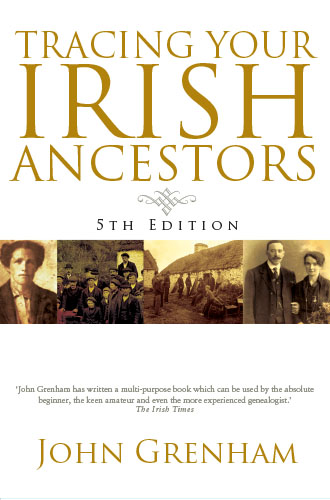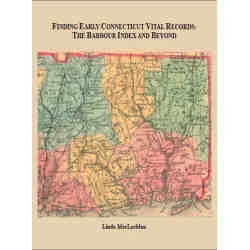
We are proud to report that we have received glowing reviews for five recent publications. If your ancestors came from one or more of the following countries: Russia, Germany, Sweden, Ireland, or Mexico, we strongly encourage you to check out the appropriate review(s) that follow. Maybe you haven’t heard about one or more of these titles before, or maybe you have heard but were on the fence about purchasing it. Now, you don’t have to take our word for it, read what the experts have to say about these stellar publications.
1. Tracing Your Irish Ancestors. Fifth Edition, by John Grenham. Reviewed in “Be Rooted Genealogy,” by Bridget Sunderlin Nov. 5, 2020.
BE ROOTED GENEALOGY, NOVEMBER 5, 2020 MY IRISH ROOTS IRISH GENEALOGY IRISH RESEARCH. BOOK
Tracing Your Irish Ancestors, Fifth Edition. By John Grenham. Published in 2019 by Genealogical Publishing Company (by arrangement with Gill Books), 3600 Clipper Mill Road, #229, Baltimore, Maryland 21211-1953. https://genealogical.com/. ISBN: 9780806320977. XXI + 650 pp. Item #7730, Hardback, $38.50.
Everyone has a hero within the industry they work in. Those of us lucky enough to be genealogists, whose research focuses within Ireland, consider John Grenham to be that hero. When Grenham revises a book, even one you may already own, you find a prominent place for it on your bookshelf.
Tracing Your Irish Ancestors, 5th Edition (2019) along with the 4th Edition (2012).John Grenham has long been a key researcher in Ireland. From his work writing the “Irish Roots ” column for the Irish Times to his groundbreaking Irish Ancestors website, Grenham is considered to be the definitive source on Irish family history. Not only is Tracing Your Irish Ancestors, Fifth Edition the perfect companion to his Irish Ancestors website, it may well be the definitive book on Irish genealogy in existence today.
Published about seven years after the fourth edition, this revision hopes to shed light on the new resources and records now available to the family researcher, whether they investigate online or onsite. Ireland, in Grenham’s own words has “become one of the world leaders” when it comes to free online access to a plethora of records (p. XV). This fact, coupled with Grenham’s updates, makes all of us with Irish roots quite lucky, indeed.
One of the greatest gifts John Grenham offers in Tracing Your Irish Ancestors, Fifth Edition may be his easy-to-follow, step-by-step approach found within “Where to Start. Not only is his advice helpful for the beginner, but it also slows down the eager intermediate researcher, ensuring that they follow sound research methodology. He then cleverly leads researchers to online sources available to help connect emigrant descendants back to their homeland. It is strongly advised by this writer that genealogists of all experience levels read Grenham’s priceless “Introduction ” (p. XVI).
Thus, having a much sturdier foundation in place, readers will find record source groups divided across chapters one to twelve. Every trick of the trade can be found within these chapters. This includes how and where to access records, and research tips to effectively focus research within each group. Record groups include but are not limited to the census, land, genetics, probate, parochial and civil birth, marriage and death records. Each chapter demonstrates a depth and breadth of knowledge that only a man like John Grenham could possess, having completed hands-on, in-the-trenches research over the course of his career.
If that isn’t enough to get a researcher started, chapters thirteen to fourteen explore each county with precise source lists and Roman Catholic parish registers. These targeted chapters encompass two-thirds of the volume, and are not only comprehensive, they may actually be exhaustive in nature. Once a genealogist has identified their ancestor’s specific county of origin, every known resource is at his or her fingertips. Online resources are highlighted for easy access. Within the final chapter, readers will find local repositories, researchers and genealogical societies that should be used when completing onsite research.
John Grenham’s goal with Tracing Your Irish Ancestors, Fifth Edition was to include the numerous resources Ireland has opened over the course of the last decade. These alone make this new edition a must-have guidebook for any genealogist studying his or her Irish roots. View Book Details
2. Genealogy at a Glance: Russian Genealogy Research, by Vera Ivanova Miller. Reviewed in “Empty Branches of the Family Tree” by Linda Stufflebean.
GENEALOGY AT A GLANCE: RUSSIAN GENEALOGY RESEARCH BY VERA IVANOVA MILLER: A REVIEW
MARCH 4, 2021 LINDA STUFFLEBEAN
DISCLAIMER: I occasionally receive complimentary copies of books to review, including today’s book, from Genealogical Publishing Company. However, my opinions are my own and not influenced by perks.
The Genealogy at a Glance series by Genealogical Publishing Company includes excellent topics, one of which is the subject of today’s review – Russian Genealogy Research.
Vera Ivanova Miller is also the author of Find Lost Russian & Ukrainian Family, so is well versed in Russian and Eastern European genealogical research.
If you are unfamiliar with the format of Genealogy at a Glance, each topic is a four page brief with hard lamination, making it perfect for tucking into research bags for library visits. It doesn’t take up much shelf space in your reference library either.
CONTENTS
Quick Facts and Important Dates
Russian Emigration
Russian Names – Surnames & Patronymic Names
Religions of Russia
Conversion to the Gregorian Calendar
Locating Russian Ancestral Places – Maps
Communist-Era Databases
Archives in Russia
Metrical Books (Parish Registers)
Censuses
Russian Consular Books
Quick Guide to the Russian Alphabet
Other Online Resources
While it is possible to just jump in and begin genealogical research in a new location, Russia presents a number of obstacles outlined in this At a Glance guide.
There is definitely a lot to learn about genealogical research in Russian records. Although I have no Russian ancestral lines, I do have Eastern European ancestors, which made me aware of some of the difficulties when researching Slavic peoples.
Vera Miller has done an excellent job highlighting areas that may be problematic for inexperienced genealogists and summarizing an overview of Russian family history resources.
First on the problem list is the Cyrillic alphabet, which is unfamiliar to most of the Western world. Let’s face it – if we can’t read the record, we aren’t going to get very far building the family tree.
I love the Quick Guide to the alphabet, which is one of the most useful bits of information in this guide. I’ve had my own experiences trying to read Cyrillic alphabet records, as the political boundaries of Eastern Europe have changed many times. With governmental changes came official language changes that literally appeared overnight.
Next, one would need to know what online resources might be available. Vera’s suggestions are not the typical big-name companies and include Cold War-era databases, which I also like.
The other information categories listed in the Contents are self explanatory and point out the necessity of basic knowledge of Russian history and culture.
There are many records to be accessed if we know how to navigate the system.
I am a fan of the At a Glance series of genealogy guides in general, but I have to admit that I think this is one of the very best At a Glance guides that will help any genealogist researching Russian ancestors.
Genealogy at a Glance – Russian Genealogy Research by Vera Ivanova Miller is published by Genealogical Publishing Company, 2021 and is available for $9.95. It’s a bargain! Given the difficulties navigating Russian research, $9.95 may well be the best money you ever spend on genealogy. View Book Details
3. Historic German Newspapers Online. 2nd Edition, by Ernest Thode. Reviewed in “The Genealogy Blog,” January 26, 2021.
Historic German Newspapers Online. Second Edition; by Ernest Thode; 2018; 329 pp•, 6×9; Soft Cover; Perfect Bound; ISBN: 9780806320922 Item # GPC5760D.
Your German genealogy research will not be complete until you have thoroughly examined all of the resources available—and that includes a search of German-language newspapers. Astonishingly, there are more than 2,000 historic German-language newspapers online at numerous public, private, and commercial websites. The combined newspapers comprise billions of pages and refer to millions of individuals. This book will help you discover all digitally available German-language newspapers 50 years or older, search them by location and title, and narrow down the dates for which they are available online. The genealogical information you can find in these newspapers is almost limitless. It includes notices of births, marriages, and deaths from civil registrations; baptisms and wedding announcements from churches; intentions to emigrate; trade news; lists of pupils; appointments to office; promotions, transfers, and retirements; deaths and estate sales; lists of hotel guests; and a multitude of everyday notices.
Since the first edition of this book was published in 2014, a great many more historic German newspapers have been digitized, prompting the need for this enlarged second edition, which is nearly 100 pages longer than the previous edition. The book’s coverage is quite literally worldwide. Of course, by far the largest number of German-language newspapers online are from Germany, followed by Austria, then present-day Poland. But more than two dozen other countries throughout the world are represented, including Australia, Belgium, Brazil, Canada, China, Czech Republic, Egypt, Estonia, France, Georgia (country), Italy, Latvia, Lithuania, Luxembourg, Mexico, Norway, Paraguay, Russia, Samoa, Serbia, Slovakia, Slovenia, Switzerland, Tanzania, Turkey, Ukraine, and the United States.
To use this book, first go to the Places section, look up your locality of interest or the largest nearby city, and note the title of the paper and the years covered. In non-German countries, look for large cities or capital cities. Next, go to the Titles section, noting the abbreviation for the URL (website) where it is located. Then click on the Key to URLs section and go to the website corresponding to the abbreviation you found.
Whether you are a genealogist, family historian, demographer, migration researcher, or social historian, you’ll find that these newspapers are extremely useful resources. View Book Details
4. Genealogy at a Glance: Mexico Genealogy Research, by Debbie Gurtler, A.G., reviewed in the Dallas Genealogical Society ENews, February 20, 2021, by JoAnn Valentin.
Dallas Genealogical Society E-News, February 2021
Genealogy at a Glance: Mexico Genealogy Research
Review by JoAnn Valentin, Community Outreach, HOGAR de Dallas
Genealogy at A Glance publications offer a series of fact sheets designed to allow family historians a quick understanding of the fundamentals of genealogy. A publication by Debbie Gurtler, AG, “Genealogy at A Glance: Mexican Genealogy Research”, lays out all the basic elements of Mexican family history research in an easy-to-use format. The first section offers “Quick Facts and Important Dates” to help the researcher focus on the historical timeline, allowing for a broader perspective of the lives of their ancestors.
The next topic covers the valuable clues offered in Hispanic naming traditions. This is a brief description and does not mention that it was common in the Spanish Colonial era to use the surname of a maternal grandparent or great-grandparent. This decision was usually motivated by the status associated with the surname.
After a brief description of the jurisdictional background of Mexico, Ms. Gurtler describes the four major record sources: civil registration records, Catholic parish records, census records, and immigration records. Most important of these is the detailed description of the Catholic Parish Marriage Records and dispensations. Many researchers are unaware of the treasures of information that these records offer, since before a dispensation was granted, extensive genealogical information was submitted for approval. Ms. Gurtler provides some excellent sources on where to research these records.
Also included is a list of online resources and some useful supplementary record sources and language aids. For those who are just starting out on their genealogy journey, or have been at it for years, this publication provides an opportunity to learn and grow as a researcher. View Book Details
5. Genealogy at a Glance: Swedish Genealogy Research, by Robert Johnson, JD. Reviewed in the National Genealogical Society Quarterly, by Elizabeth Williams Gomoll, CG.
Genealogy at a Glance: Swedish Genealogy Research. By Robert Johnson, JD, CG. Published by Genealogical Publishing co., Inc.;3600 Clipper Mill Road, Suite 229; Baltimore, MD 21211; http://www.genealogical.com/; 2020; ISBN 978-0-8063-2105-9. 4 pp. Laminated and folded. $9.95.
In four succinct pages Johnson equips researchers with a meaningful overview of topics and resources essential to researching Swedes and those who emigrated. Genealogists new to Swedish research will find this laminated guide provides a quick understanding of Swedish culture and record types. More experienced researchers will appreciate the content-rich summaries as reminders of places to look for elusive answers. Helpful tips are presented throughout.
The first page includes a table-of-contents. In five bullet points the section “Quick Facts” gives perspective on the number of Swedes who came to the United States, where they concentrated, and how many returned to Sweden.
“Swedish Immigration to North America” is divided into three subtopics. First, “New Sweden: 1638—1655” summarizes the history of the earliest arrivals to North America. “Sweden’s Great Migration 1850—1930” has useful clues for ports of departure and arrival. Lastly, “Migration Records” references several online sources for migration documents.
The two inside pages boil down Swedish history and record types into concentrated paragraphs. “Unlocking Swedish Family History’ will be especially helpful to newer Swedish researchers. Subsection “Swedish Language” explains the three letters in the Swedish alphabet unfamiliar to English speakers and cautions how non-standardized spellings can trip up unsuspecting researchers. “Names” encourages flexibility when it comes to spelling and explains the patronymic naming system that often stymies the uninitiated.
“Major Record Sources” addresses household examinations; birth, marriage, and death records; moving, tax, and census records;- estate inventories; and court, military and land records. Each of these record types receives a meaty summary that underscores the fact that understanding the history behind and reason for a record leads to smarter use of that record. Approximate timespans are offered for each record type, and Johnson again directs the user to online resources.
The back page may be the most frequently referenced part of this guide. “Repositories” describes the archives containing Sweden’s essential records: Riksarkivet (National Archives), Landsarkiven (Provincial Archives), and Krigsarkivet i Stockholm (Military Archives). Web and postal addresses are given. “Other Online Resources” provides URLs and descriptions for eight essential websites offering digitized images of Swedish records.
Currently only four English-language genealogical research books focus on Swedish research. This quick guide is like the CliffsNotes for those books. One hopes similar guides will soon be available for other Nordic countries.
Elizabeth Williams Gomoll, CG St. Paul, Minnesota ewgomoll@icloud.com View Book Details









